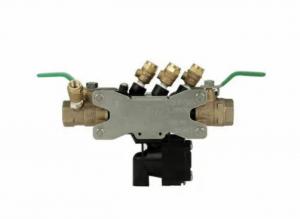Backflow Parts and More Provides Essential Guide to Backflow Parts
Understanding backflow prevention and its components is crucial for maintaining a safe and clean water supply.
DENVER, NC, USA, November 1, 2023 /EINPresswire.com/ -- Understanding backflow and its potential dangersBackflow occurs when water flows in the opposite direction than intended, potentially contaminating the clean water supply. This can happen due to a sudden drop in pressure, a back siphonage event, or a backpressure event. Backflow can introduce harmful substances, such as chemicals, bacteria, or waste, into the drinking water system, jeopardizing public health.
To prevent backflow, backflow prevention devices are installed in plumbing systems. These devices ensure that water flows in only one direction, keeping the clean water supply separate from potential contaminants. Understanding the dangers of backflow and the importance of backflow prevention is crucial for safeguarding the health of everyone.
One common example of backflow is when a garden hose is left submerged in a pool or a bucket of chemicals. If the water pressure drops suddenly, such as during a water main break or firefighting activity, the pool water or chemicals can be drawn back into the hose and contaminate the drinking water supply. This is why backflow prevention devices are essential in residential, commercial, and industrial plumbing systems.
Another potential danger is backpressure, which occurs when the pressure in the plumbing system exceeds the pressure in the public water supply. This can happen when a boiler or a large pump is connected to the plumbing system. If the pressure in the system is higher than the supply pressure, it can cause water to flow back into the public water system, potentially contaminating it.
Understanding the potential dangers of backflow is the first step towards preventing contamination and maintaining a safe water supply.
Common backflow prevention devices
Backflow prevention devices come in various types and sizes, each designed to prevent backflow in different scenarios. Some of the most common backflow prevention devices include check valves, reduced pressure zones (RPZ), backflow preventers, and air gaps.
Check valves are simple devices that allow water to flow in only one direction. They feature a hinged flap or a swinging gate that opens when water flows in the desired direction, and closes to prevent backflow. Check valves are commonly used in smaller plumbing systems, such as individual fixtures or appliances, to prevent backflow from occurring.
Reduced pressure zones (RPZ) are more complex backflow prevention devices used in larger plumbing systems or where the risk of contamination is high. RPZ devices consist of two check valves and a relief valve, creating a zone of reduced pressure between the check valves. This zone acts as a barrier, preventing backflow from occurring even when there is a drop in pressure in the water supply.
Backflow preventers are versatile devices that can be used in a variety of applications. They consist of multiple check valves and air vents, providing a high level of backflow protection. Backflow preventers are commonly used in residential, commercial, and industrial plumbing systems to prevent backflow in various scenarios.
Air gaps are the simplest and most reliable form of backflow prevention. An air gap is a physical separation between the water supply and the potential source of contamination. It ensures that even if backflow occurs, there is no connection between the clean water supply and the contaminated water. Air gaps are commonly used in situations where there is a high risk of contamination, such as in industrial processes or where chemicals are involved.
Where to Buy Backflow Parts
When purchasing backflow parts, ensure that they meet the necessary certifications and comply with local regulations. It is also recommended to consult with a qualified professional or a certified backflow prevention specialist to ensure that you are selecting the right components for your system.
Conclusion: Ensuring a safe and reliable water supply with backflow prevention.
In conclusion, understanding backflow prevention and the role of backflow parts is essential for maintaining a safe and clean water supply. Backflow can introduce harmful substances into the drinking water system, jeopardizing public health. By installing the right backflow prevention devices and maintaining them properly, can prevent backflow and ensure the safety of the water supply. By being proactive in preventing backflow and ensuring the proper functioning of backflow parts, you can enjoy a safe and reliable water supply
Leslie Reeves
Backflow Parts and More
+1 704-975-0070
email us here
Visit us on social media:
Facebook
Legal Disclaimer:
EIN Presswire provides this news content "as is" without warranty of any kind. We do not accept any responsibility or liability for the accuracy, content, images, videos, licenses, completeness, legality, or reliability of the information contained in this article. If you have any complaints or copyright issues related to this article, kindly contact the author above.

